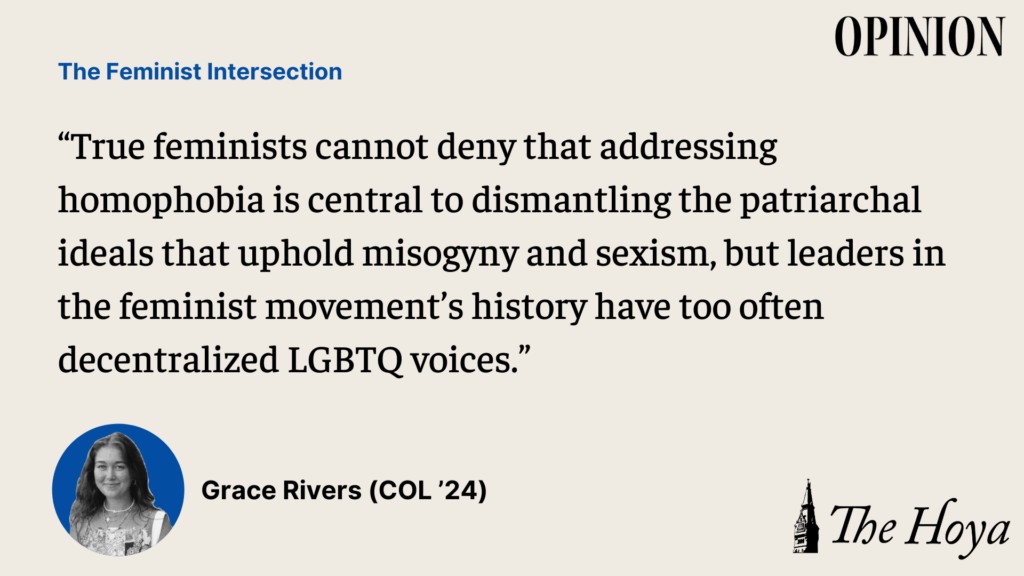My girlfriend and I are well acquainted with glaring strangers on the street when we hold hands. While we are fortunate to live in an increasingly accepting society, we must still be conscious of where we display our affection publicly.
Despite the legalization of same-sex marriage in 2015 in the United States, homophobia and microagressions against the LGBTQ community are still prevalent, especially during the era of the Trump administration. According to NBC news, anti-LGBTQ groups were among the fastest-growing sector of hate groups in 2019.
However, my identity as an LGBTQ individual is not the only thing that leaves me vulnerable to such prejudices.
While my 80-year-old grandmother has been very accepting of my identity and nothing but kind to my girlfriend, there are the occasional hurtful remarks. After family dinner one night, she approached me and asked, “When are you going to date a real boy?”
Her question implied that my role and worth as a woman is dependent on my ability to love and serve a man.
The feminist movement has often failed to recognize that homophobia and misogyny are inextricably tied and are often both used to uphold traditional gender roles that seek to control women and their bodies. As a result, modern feminism must continue to work to centralize LGBTQ voices. A fight against sexism must always include a fight against homophobia.
Those who identify as both a woman and an LGBTQ individual experience a unique set of prejudices. For example, according to the Rape, Abuse and Incest National Network (RAINN), one out of every six American women is a victim of attempted or completed rape, compared to one in thirty-three men.
This statistic is even more exacerbated among LGBTQ women: according to a report by Williams Institute, a section of UCLA Law dedicated to research on the basis of sexual orientation and gender identity, LGBTQ women are five times more likely than non-LGBTQ women to experience violent victimization.
Additionally, the assumption that there must be a “man” in a homosexual relationship between two women relies on patriarchal ideals that have held women down for much of history.
My girlfriend and I have received the same question on numerous occasions: “Who is the man in the relationship?” Even if the question is a well-intentioned attempt to better understand the dynamic of our relationship, it still largely relies on misogynistic assumptions.
This question implies that in order for a relationship to exist and be successful, there must be a male figure, as if two women are not capable of growing and sustaining a relationship without someone to fill a traditional “male role” as defined by patriarchal terms. This belief restricts women to the role their gender has filled for much of history: the homemaker who is supported by a strong, dominant, breadwinner male figure.
True feminists cannot deny that addressing homophobia is central to dismantling the patriarchal ideals that uphold misogyny and sexism, but leaders in the feminist movement’s history have too often decentralized LGBTQ voices.
The National Organization for Women (NOW) is an American feminist organization that was founded in 1966. Within the first few years of its founding, lesbian women who were members of the organization were denied leadership positions if they called for centralization of lesbian rights within the feminist cause. Many argued that centralization of lesbian issues would taint their mainstream credibility, as the first objective was to achieve equality for white, heterosexual women before others with intersecting identities could be included within the movement.
While the movement has made significant strides since then to more sufficiently address the rights of women of all sexual orientations, there is still much work to do to expand what it means to be a feminist.
Perhaps the most fundamental action we can take is to avoid viewing lesbian relationships through heterosexual norms. Women can and have existed outside their stereotypical gender role for centuries, and a relationship is more than capable of being sustained without a male figure.
This isn’t always an easy task though. We must be committed to holding each other accountable in a constructive and compassionate way. Only then can we truly make a collective effort to fight the homophobia that is inextricably tied with sexism and the feminist movement.
Grace Rivers is a sophomore in the College. The Feminist Intersection is published every other week.









